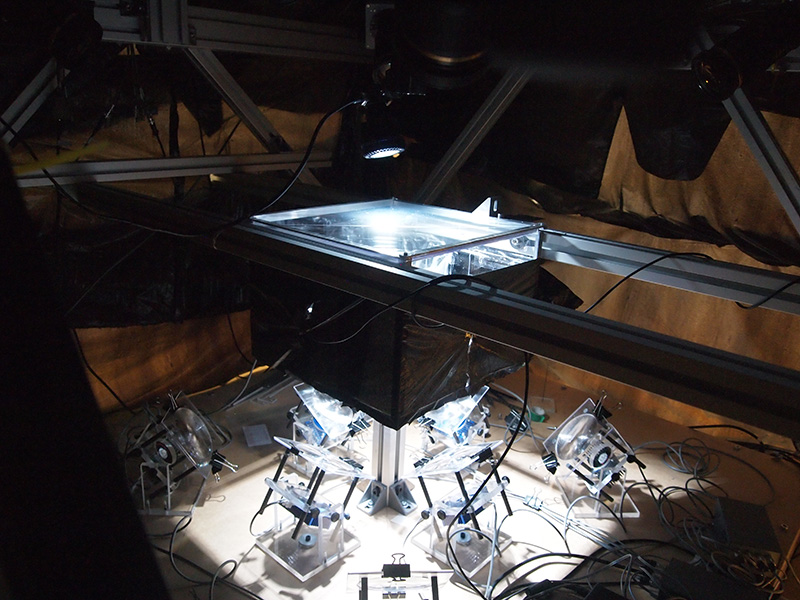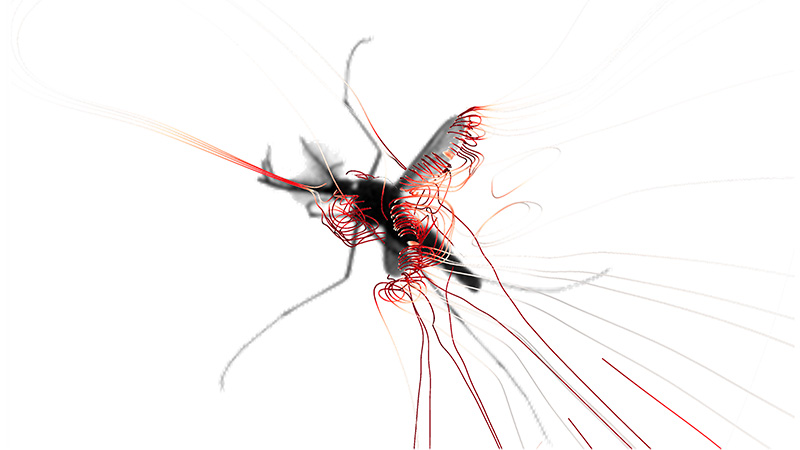Reasons behind mosquitoes’ unusual flight behaviour identified in new study
The reason behind mosquitoes’ unusual flight behaviour has long puzzled scientists. The angular sweep of their wings is around 40 degrees, which is less than half that of the honey bee, prompting speculation over how they fly at all.
Research led by scientists from the Royal Veterinary College (RVC), has identified two additional aerodynamic features which help explain these unusual features.
Mosquitoes stand out from other insects for their unusual flight behaviour. They have abnormally long, narrow wings, which they flap back and forth 800 times each second – far faster than any other insect of comparable size. To compensate for these rapid oscillations, their stroke amplitude (the angle through which the wing sweeps) is less than half that of any other insect measured to date. This unusual flapping pattern of short, fast sweeps means that mosquitoes cannot rely on the conventional aerodynamic mechanisms that most insects (and helicopters) use.
This unusual flight behaviour prompted scientists from the Royal Veterinary College, University of Oxford, and Chiba University to carry out a study, which is published today in Nature. The results from this study show that there is still much to be learnt from animals, such as mosquitoes, which operate at the extremes of natural flight.
The scientists built a miniature film studio, using precisely aligned cameras and powerful lights, to capture the subtle three-dimensional movements of their wings. This allowed the researchers to observe the subtlest of movements, which were then placed into a computational fluid dynamics model that could simulate the airflow produced by the beating wings.

The team found that in addition to generating lift by leading-edge vortices (a mechanism used by most insects, whereby ‘bubbles’ of low pressure are created along the leading edge of the wing), mosquitoes use two additional aerodynamic features: so-called trailing-edge vortices, and a type of lift mechanism generated by the rotation of the wing.
Whereas other insects produce most weight support during the translational phases of their down- and up-strokes, the unique wing shape and motion of mosquitoes means that their weight is most supported during the brief periods of wing rotation at the end of each half-stroke. This, in turn, gives rise to vortices on the wing’s trailing edge caused by a new form of wake capture (a phenomenon whereby the insect gains extra lift by recapturing energy lost in the previous stroke).

Dr Richard Bomphrey, Reader of Biomechanics at the RVC, and study lead, said: “The usual flapping pattern of short, fast sweeps means that mosquitoes cannot rely on the conventional aerodynamic mechanisms that most insects and helicopters use. Instead, we predicted that they must make use of clever tricks as the wings reverse their direction at the end of each half-stroke.”
Dr Simon Walker, University Research Fellow at the University of Oxford, who helped design the intricate setup said: “Recording mosquitoes during free-flight represented a huge technical challenge due to their small size, extreme wingbeat frequency, and the presence of large antennae and legs, that can mask the view of their wings”.
Dr Toshiyuki Nakata, from Chiba University, who ran the computer simulations, said: “In most insects, aerodynamic forces increase as you move out along the wing length because the wing tip travels faster than the wing root. However, by exploiting aerodynamics that rely on rapid pitching of the wing, the force can be produced along the entire length. Having a long slender wing can therefore increase lift force and simultaneously reduce the cost of flight.”
Research Reference
Bomphrey RJ, Nakata T, Phillips N, Walker SM. Smart wing rotation and trailing-edge vortices enable high frequency mosquito flight. Nature 2017/03/29/online. 10.1038/nature21727
Press Office Contact
Uche Graves / Zoe White
T: 0800 368 9520
E: uche.graves@plmr.co.uk / zoe.white@plmr.co.uk
Notes to Editors
The Royal Veterinary College (RVC) is the UK's largest and longest established independent veterinary school and is a constituent College of the University of London. The RVC offers undergraduate, postgraduate and CPD programmes in veterinary medicine, veterinary nursing and biological sciences, being ranked in the top 10 universities nationally for biosciences degrees. It is currently the only veterinary school in the world to hold full accreditation from AVMA, EAEVE, RCVS and AVBC.
A research-led institution, in the most recent Research Excellence Framework (REF2014) the RVC maintained its position as the top HEFCE funded veterinary focused research institution.
The RVC also provides animal owners and the veterinary profession with access to expert veterinary care and advice through its teaching hospitals; the Beaumont Sainsbury Animal Hospital in central London, the Queen Mother Hospital for Animals (Europe's largest small animal referral centre), the Equine Referral Hospital, and the Farm Animal Clinical Centre located at the Hertfordshire campus.
RVC Press Release 29 March 2017
See other Press Releases.
You may also be interested in:
-
New research from the RVC explores the functions of leg muscles and structures in running
Research from the Royal Veterinary College (RVC) has explored the functions of leg muscles, …

